- Wondering how to get Monopoly GO! free rolls? Well, you’ve come to the right place. In this guide, we provide you with a bunch of tips and tricks to get some free rolls for the hit new mobile game. We’ll …
Best Roblox Horror Games to Play Right Now – Updated Weekly
By Adele Wilson
Our Best Roblox Horror Games guide features the scariest and most creative experiences to play right now on the platform!The BEST Roblox Games of The Week – Games You Need To Play!
By Sho Roberts
Our feature shares our pick for the Best Roblox Games of the week! With our feature, we guarantee you'll find something new to play!All Grades in Type Soul – Each Race Explained
By Adele Wilson
Our All Grades in Type Soul guide lists every grade in the game for all races, including how to increase your grade quickly!
Sprill Diaries: The Fox is Back!
Alawar’s fox cub Sprill has become a recognizable mascot in casual games, having headlined three successful titles including his latest hidden object adventure Sprill & Ritche: Adventures Through Time. In this post-mortem, Alawar Entertainment’s Maxim Michaelis and Tatiana Chernova, and Alawar Five-BN CEO Eugeny Sokolov look back on the development of Sprill & Ritchie: Adventures Through Time and how the character of Sprill evolved.
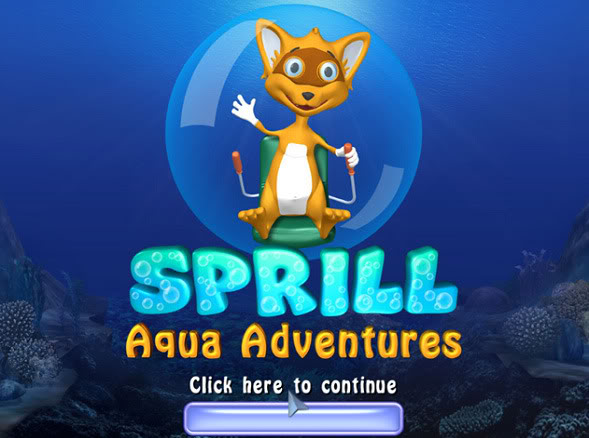
Alawar’s fox cub Sprill has become a recognizable mascot in casual games, having headlined three successful titles including his latest hidden object adventure Sprill & Ritche: Adventures Through Time. In this post-mortem, Alawar Entertainment’s Maxim Michaelis and Tatiana Chernova, and Alawar Five-BN CEO Eugeny Sokolov look back on the development of Sprill & Ritchie: Adventures Through Time and how the character of Sprill evolved.
Tatiana Chernova
Director of Marketing Communications and PR, Alawar Entertainment
What makes a game successful: its story, graphics or gameplay? All of those things matter, but the most important ingredient is charismatic characters. A chubby plumber and a blue hedgehog brought their creators worldwide fame and millions of dollars. All of that was possible because of their incredible charisma.
In the casual games industry, you can’t succeed without the "cute" factor. When we started work on Sprill: Aqua Adventures, the first game featuring Sprill, Alawar and Five-BN (now Alawar Five-BN) had a collective brainstorming session. We had tons of concepts ranging from a goofy elephant to a beautiful fairy. And it was only one day before Casual Connect Kiev 2006 when Eugeny Sokolov, Five-BN CEO, had a great idea: Sprill should be a fox cub, a red-furred, comical and optimistic adventure-seeker who’d go to great lengths to achieve his goals. How would a princess look controlling a mini-sub or riding on a turtle’s back? Absurd! Sprill looked quite natural in all of these situations.

We followed Aqua Adventures with another game featuring the now famous fox – a casual adventure title called Sprill: The Mystery of the Bermuda Triangle. The project turned out to be financially successful, so we decided to make Sprill the star of an entire series of games. A decision to make another adventure title was made during the traditional Kyiv conference, but this time, the game would be created in a totally different setting. The project evolved into Sprill and Ritchie: Adventures in Time. Although Sprill was the same lovable fox cub, the character evolved over the course of the game’s development. Plus, Sprill got a new friend – an eccentric inventor named Ritchie.
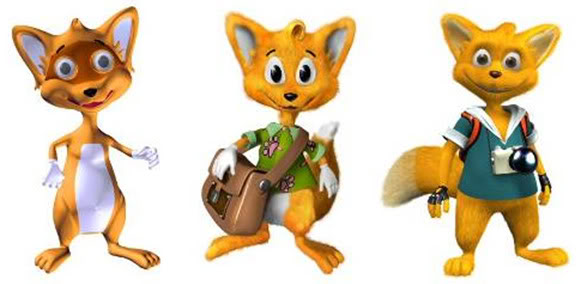
Maxim Michaelis
Art Director, Alawar Entertainment
When we started working on Sprill and Ritchie: Adventures in Time, we faced a number of challenges: from improving the overall quality of the graphics to enhancing the facial and body animation of Sprill, our red-furred traveler, and his cranky companion, Ritchie. We strove to create dynamic and realistic characters, each with his own traits and peculiarities. Sprill is all about common sense – a cute and plump contemplator who’s never in a rush and who always treats everything discreetly. Ritchie, on the other hand, is a typical hothead – agile, hectic and razor-sharp. The most suitable comparison would be Doc from the "Back to the Future" movies, although Ritchie is a squirrel, of course.

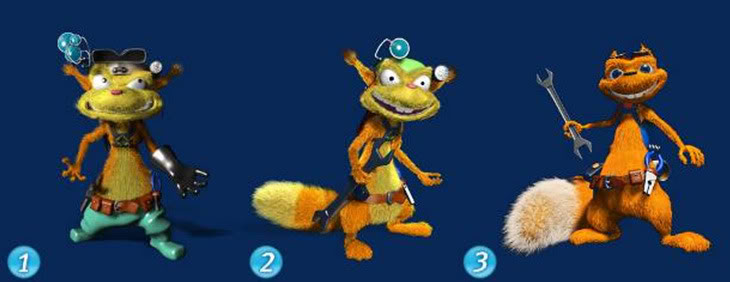
The evolution of Ritchie
We had several art concepts for Ritchie, but we had to turn down the first three. There were too many small details in the first concepts that did nothing to clearly identify the character, and Ritchie’s face was kind of weird. We got rid of the unnecessary minutia like hair on his ears, made other objects larger, replaced a crazy grin with a nice smile and put goggles on his head.
We spent a lot of time working on Sprill. In the beginning, he looked fairly lackluster, almost like an emotionless goof. However, we managed to breathe life into him – mostly using color and facial animation.

After this part of the work was done, our artists switched over to the user interface. We wanted to create an unusual steam punk style to support the storyline, where a lot of attention is given to Ritchie, who is a mechanic and an inventor. To do that, we used a lot of bolts, clips and braces to create a corresponding atmosphere. We also made all the buttons look metallic. The tip indicator was created in a very unusual manner – it looked like an old fashioned gauge with a dial.
A couple of words about the logo. If you take a closer look at it, you’ll notice that it consists of two separate parts. The top part (the globe) symbolizes Sprill, a traveler, while the bottom part (a gear) stands for Ritchie, an inventor. It took us some time to come up with this concept. Initially, we experimented with fonts and shapes, but later decided to try combining stylized objects. Logo placement was also a bit of a problem. It was initially inserted into the main menu to see the whole picture and assess its aesthetics in a dynamic environment.

Cutscenes became one of the key components of the game. We focused on dynamically changing camera views and zooming effects, and on Sprill and Ritchie’s conversations and their reactions to different events. We attempted to show their personalities through communication and not just tell a story about their adventures.
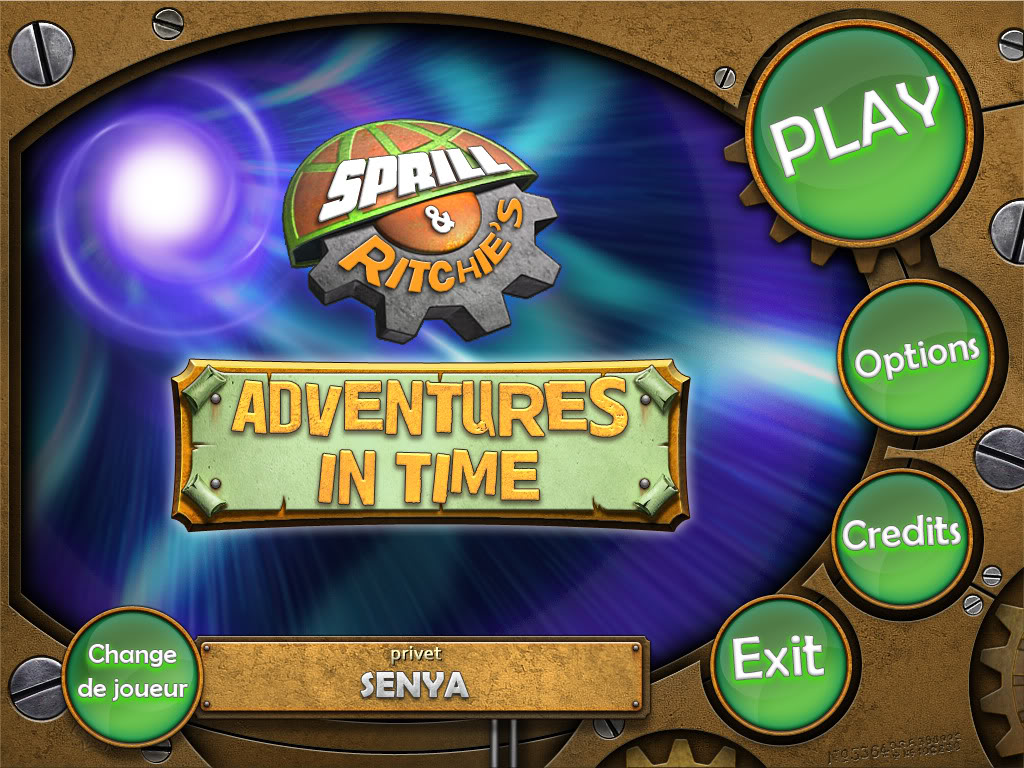
I think I also need to say some words about the production process. At Alawar Five-BN, it is implemented in the form of a conveyer. Each member of the team works on a completely separate task and passes the results over to the next person in the production chain: some artists are working on concept art, some are creating game models and others are busy with game textures. As the result, all of our employees get better in their fields of expertise and the process is not centered on a single expert. When a project is finished, the team is assigned to another one, but the structure of the conveyer and the roles of the team members remain the same. We had some difficulties with task distribution and task priorities, but this know-how enabled us to tackle all of these problems and create an efficient production process.
Eugeny Sokolov
CEO, Alawar Five-BN
The main feature of Sprill and Ritchie: Adventures in Time was its scale. You’ll need six to eight hours of gameplay time to beat the game. And I’m talking about skilled casual gamers with solid experience in the hidden object genre. Novices will need much more time.
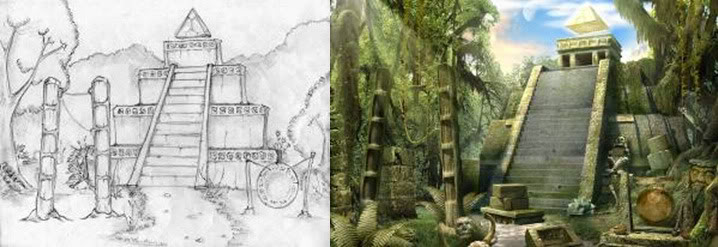
The creation of this game was very labor- and resource-intensive and took us around eight months to complete. First, we created a story and revised it several times. Our writers did their best to fill the dialog with humor and spice it up. Attentive gamers will notice some cultural references, especially the ones to House M.D., a super-popular TV series.
We created detailed descriptions for each game location with comments on each quest element and item. Then we created artwork for each location and detailed schemes for mini-games. Work on the actual graphics started after that, when the approved art concepts were inserted directly into the project. Once done, we applied actions and special effects to them and started the long and scrupulous testing phase.
While talking about the sequel, I cannot help comparing it to the original game. Sprill has changed and become more mature, as we seriously changed the in-game mechanics and made them more exciting. Now you need to search for objects united by a single property (as in The Treasures of Mystery Island) or collect their parts (as in Magic Encyclopedia). We did our best to fill these searches with a sense of purpose (unlike in many hidden object games) and back them with a good story. For instance, if Sprill is getting ready for a long journey, he’ll need to find all of his travel gear and pack some food. In another episode, the little fox must find every modern item to prevent a global catastrophe.
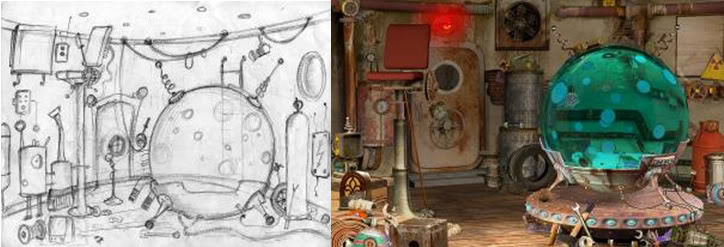
We don’t give players a predefined set of abstract items to find; rather, they will know what type of objects to find based on the scenario. And tasks can change during the game. Sometimes, Sprill has to solve fairly simple puzzles or beat mini-games to accomplish certain tasks.
We also added the ability to apply one item to another, just like you do in hardcore adventure games. It might have complicated the gameplay slightly, but there aren’t many situations of this kind in Sprill & Ritchie. I hope these manipulations don’t cause problems for you. If they do, you can always use the hint feature.
If you take a close look at the screenshots, you’ll notice the improved graphics. In the first two Sprill games, our fox travelled through an underwater world, which had corresponding backgrounds. In Sprill & Ritchie, Sprill embarks on an exciting journey across various countries and time periods, and interacts with all kinds of cultures. He starts out in the caves of the Stone Age and then visits medieval castles and Egyptian pyramids, only to finish his adventure in the scientific laboratories and automated factories of the distant future.
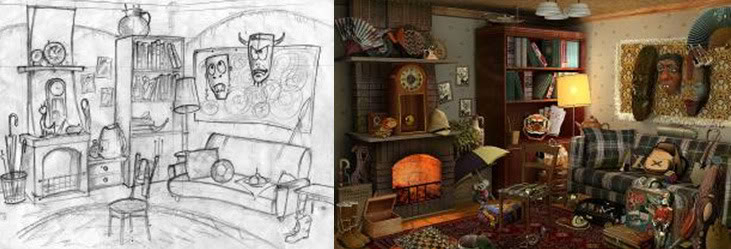
Every background image was rendered in great detail. Initial sketches were created with the final result in mind. We carefully picked the items which would be used as decoration and the ones that would be needed to solve the quests. And we gave a lot of attention to the quality of the main characters. For instance, we used a special plug-in to create realistic fur on our characters. The result was impressive — the fur did look like real.
As for the game engine, it didn’t change much, although we did decrease the load time and optimize memory consumption.
Sprill is truly unstoppable now, so Adventures in Time will hardly be the last game in this series.
I’d like to congratulate all of my colleagues here at Alawar Five-BN on the completion of such a large and lengthy project. Thank you so much! We did an excellent job of improving the quality of the game and creating lots of exciting content. When we were approaching the final stage of development, we thought about splitting the quest into two separate games and selling them as independent products, as each part contained four to five hours of gameplay, but we decided to release a title that was much longer than other products in the hidden object genre. Our fans deserve it!
More articles...
Monopoly GO! Free Rolls – Links For Free Dice
By Glen Fox
Wondering how to get Monopoly GO! free rolls? Well, you’ve come to the right place. In this guide, we provide you with a bunch of tips and tricks to get some free rolls for the hit new mobile game. We’ll …Best Roblox Horror Games to Play Right Now – Updated Weekly
By Adele Wilson
Our Best Roblox Horror Games guide features the scariest and most creative experiences to play right now on the platform!The BEST Roblox Games of The Week – Games You Need To Play!
By Sho Roberts
Our feature shares our pick for the Best Roblox Games of the week! With our feature, we guarantee you'll find something new to play!All Grades in Type Soul – Each Race Explained
By Adele Wilson
Our All Grades in Type Soul guide lists every grade in the game for all races, including how to increase your grade quickly!







